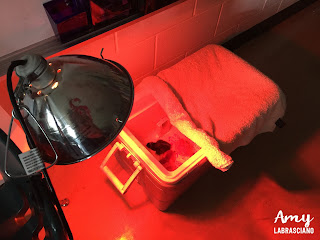Are you interested in hatching chickens with your class? If so I can promise they will be the happiest students who forever remember the experience. I can also promise you that it will be the grossest lesson you have every taught your students, but well worth it.
Supplies that you will need: fertilized eggs, incubator, brooding box (you can use a large cooler), heat lamp, thermometer, paper towels, rubber gloves, safe cleaning solution, chicken feed and waterer.
You might want to work with a local farmer to get the supplies you need. At the very least, you will need someone to return the chicks to once they are hatched.
We found the book below at out local library. It has all of the information that you will need to hatch chicks.
Follow the directions with your incubator to keep the right humidity and temperature for your eggs. Both are very important for the duration of the incubation cycle. Remember to not open the incubator unless you need to add water for humidity. You will be able to keep the incubator at school for most of the hatching cycle (if you're allowed). If you see a pip in the shell like seen below, you will have on average 24-48 hours before hatching. You don't want to unnecessarily move the eggs close to hatching, but you don't want a chick to hatch and be left in the incubator for more than 24 hours. You'll have to make the best judgment for your class.
Once the chick hatches it can be left in the incubator for up to 24 hours. I removed my chicks once they were almost dry.
 |
Once the chicks are dry you will place them in a brood box with a heat lamp. You won't want to place them with older chicks that could peck them. The brood box should start at 95 degrees and be reduced 5 degrees each week until they are 20 days. It's important that the box is large enough so that chicks can be under the lamp when they want and cooler on the other side when needed. You need to keep the room quiet and not handle the chicks for the first 24 hours or so. If you have to hatch the chicks at your home rather than school because of timing, let the chicks stay at your home for a couple of days. They don't do well with transportation after hatching.
Chicks can eat and drink right after hatching. Keep food and water in the brood box. Once they start eating the box will get dirty often. You'll have to pull the paper towels out of the box and wipe it down several times a day. Students love to do this. Make sure they wear gloves and the cleaning solution is safe for both the children and box. You'll need to bring the chicks home each night because it is not safe to leave a heat lamp unattended.
I kept the chicks at school for one week before I returned them to their farm. It's a lot of work and that's all our schedule and my patience could handle.
Here's our happy little chicks!
If you would like to read about our chicken lessons and find materials to teach your students with, click on the picture below for another blog post.














No comments:
Post a Comment